Related Research Articles

Illuminati: New World Order (INWO) is an out-of-print collectible card game (CCG) that was released in 1994 by Steve Jackson Games, based on their original boxed game Illuminati, which in turn was inspired by the 1975 book The Illuminatus! Trilogy by Robert Anton Wilson and Robert Shea. An OMNI sealed-deck league patterned after the Atlas Games model was also developed.
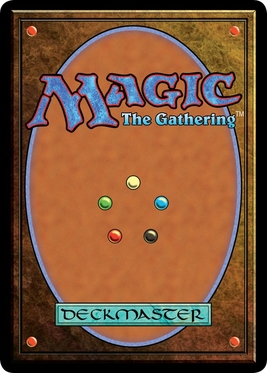
Magic: The Gathering is a tabletop and digital collectible card game created by Richard Garfield. Released in 1993 by Wizards of the Coast, Magic was the first trading card game and had approximately fifty million players as of February 2023. Over twenty billion Magic cards were produced in the period from 2008 to 2016, during which time it grew in popularity. As of the 2022 fiscal year, Magic generates over $1 billion in revenue annually.

Richard Channing Garfield is an American mathematician, inventor and game designer. Garfield created Magic: The Gathering, which is considered to be the first collectible card game (CCG). Magic debuted in 1993 and its success spawned many imitations.
Star Wars: Customizable Card Game (SW:CCG) is an out-of-print customizable card game based on the Star Wars fictional universe. It was created by Decipher, Inc., which also produced the Star Trek Customizable Card Game and The Lord of the Rings Trading Card Game. The game was produced from December 1995 until December 2001. Since 2002, the game has been maintained by the Star Wars CCG Players Committee, with new virtual cards being released every few months and the capability to play both in person and online.
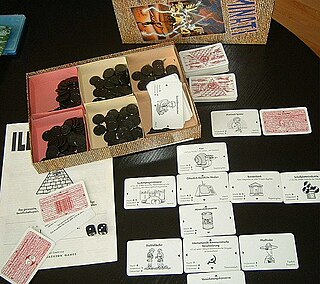
Illuminati is a card game made by Steve Jackson Games (SJG), inspired by the 1975 book The Illuminatus! Trilogy, by Robert Anton Wilson and Robert Shea. The game has ominous secret societies competing with each other to control the world through various means, including legal, illegal, and even mystical. It was designed as a "tongue-in-cheek rather than serious" take on conspiracy theories. It contains groups named similarly to real-world organizations, such as the Society for Creative Anachronism and the Symbionese Liberation Army. It can be played by two to eight players. Depending on the number of players, a game can take between one and six hours.

Castle Falkenstein is a steampunk-themed fantasy role-playing game (RPG) designed by Mike Pondsmith and originally published by R. Talsorian Games in 1994. The game is named for a legendary unbuilt castle in the Bavarian Alps. Players play the roles of gallant adventurers who take on quests of intrigue and derring-do in the spirit of Victorian adventures such as The Prisoner of Zenda.
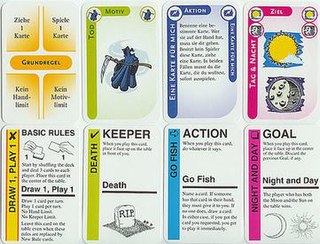
Fluxx is a card game, played with a specially designed deck published by Looney Labs. It is different from most other card games, in that the rules and the conditions for winning are altered throughout the game, via cards played by the players.

Cosmic Encounter is a science fiction–themed strategy board game designed by "Future Pastimes" and originally published by Eon Games in 1977. In it, each player takes the role of a particular alien species, each with a unique power to bend or break one of the rules of the game, trying to establish control over the universe. The game was inducted into the Academy of Adventure Gaming Arts & Design Adventure Gaming Hall of Fame in 1997.

Shadis is an independent gaming magazine that was published in 1990–1998 by Alderac Entertainment Group (AEG). It initially focused on role-playing games.
Hacker is a dedicated deck card game for 3–6 players published by Steve Jackson Games (SJG) in 1992.

Kremlin is a board game satire of power struggles within the pre-glasnost Soviet Union government of the 1980s. The game takes its name from the Kremlin in Moscow, the location associated with the central Soviet government offices. The original German-language edition was designed by Urs Hostettler and released in 1986 by the Swiss board game company Fata Morgana Spiele under the name Kreml. An English translation of the game with slightly modified rules was published by Avalon Hill in 1988. Kremlin won a 1988 Origins Award for Best Boardgame Covering the Period 1900-1946.
Jasmine: The Battle for the Mid-Realm is a fantasy-themed card game designed by DARLENE and published by her company Jasmine Publications in 1982. The game is based on DARLENE's graphic adventure Story of Jasmine published in Dragon. Although the game was well received by critics, the original print run did not sell out, and a planned expansion deck was never published.

Empire Builder is a railroad board game originally published by Mayfair Games in 1982 that underwent several editions and eventually branched out into international and fantastical locations.

Galactic Empires is an out-of-print collectible card game with a science fiction theme. It was published by Companion Games in 1994 until the company's bankruptcy in 1997.
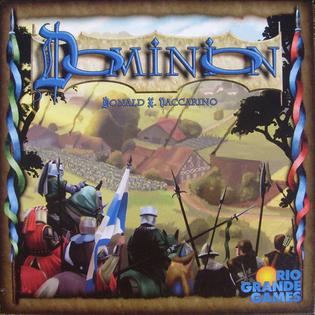
Dominion is a card game created by Donald X. Vaccarino and published by Rio Grande Games. Originally published in 2008, it was the first deck-building game, and inspired a genre of games building on its central mechanic. Each player begins with a small deck of cards, which they improve by purchasing cards from a common supply that varies from game to game. Cards can help the player's deck function, impede their opponents, or provide victory points. As of December 2022, fifteen expansions to the original Dominion have been released.
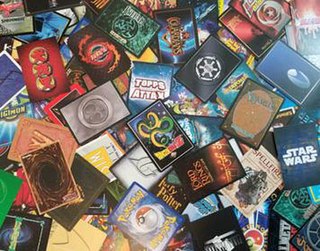
A collectible card game (CCG), also called a trading card game (TCG) among other names, is a type of card game that mixes strategic deck building elements with features of trading cards. It was introduced with Magic: The Gathering in 1993.
Dark Cults is a two-player horror card game designed by Kenneth Rahman and published by Dark House in 1983.
Creatures & Cultists is a card game for 3–5 players that was published by Pagan Publishing in 1993.
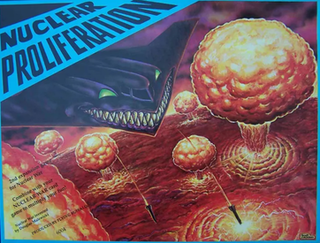
Nuclear Proliferation is a satirical card game with a theme of nuclear war published by Flying Buffalo in 1992.
EuroHit is a card game designed by Chris Baylis that was published by FCB & Associates in 1992. It was republished as Assassin by Avalon Hill in 1994.
References
- ↑ Smith, Lester (April 1994). "Roleplaying Reviews". Dragon (204). TSR, Inc.: 78.
- ↑ "Origins Award Winners (1993)". Academy of Adventure Gaming Arts & Design. Archived from the original on 2008-03-07. Retrieved 2008-03-24.